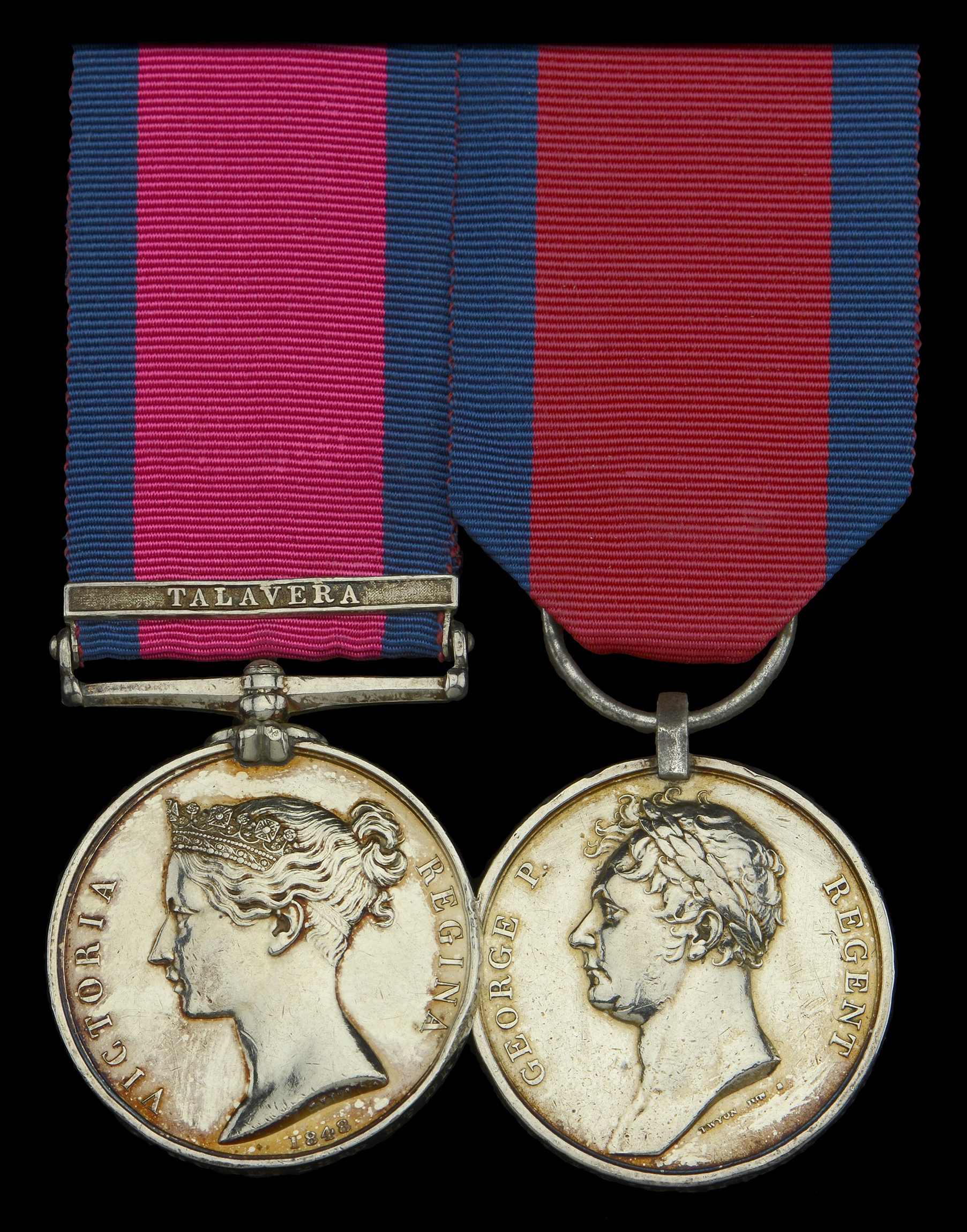Pair: Private Joseph Hurd, 23rd Light Dragoons Military General Service 1793-1814, 1 clasp, Talavera (J. Hurd, 23rd Lt. Dragns.); Waterloo 1815 (Joseph Hurd, 23rd Reg. Light Dragoons.) fitted with original steel clip and ring suspension, edge bruising to both and a light attempt to erase surname on the second, otherwise nearly very fine (2) £2,000-£2,400 --- Joseph Hurd served at Waterloo in Captain McNeill’s Troop No. 3. At the battle of Talavera, Napier records, ‘Sir Arthur ordered Anson’s brigade of cavalry, composed of the 23rd Light Dragoons and the First German Hussars, to charge the head of these columns [Villarte’s Division, some grenadiers and two regiments of light cavalry]. They went off at a canter, increasing their speed as they advanced and riding headlong against the enemy; but in a few moments, a hollow cleft which was not perceptible at a distance intervened, and at the same moment the French, throwing themselves into squares, opened their fire. Colonel Arentschild, commanding the hussars, an officer whom forty years’ experience had made a master in his art, promptly reined up at the brink, exclaiming in his broken phrase, ‘I vill not kill my young mans!’ The 23rd found the chasm more practicable, the English blood is hot, and the regiment plunged down without a check, men and horses rolling over each other in dreadful confusion; yet the survivors, untamed, mounted the opposite bank by twos and threes’ ... and ‘fell with inexpressible violence upon a brigade of French chasseurs in the rear. The combat was fierce, yet short, for Victor seeing the advance of the English, had detached his Polish lancers and Westphalia light horse to support Villatte, and these freshmen coming up when the 23rd, already overmatched, could scarcely hold up against the chasseurs, entirely broke them.’ In consequence of losing about half its strength in this action, 102 killed and 105 taken prisoner, the 23rd Light Dragoons were withdrawn to England to recruit and never returned to the Peninsula as a regiment during the remaining years of the war. Major Ponsonby of the 23rd wrote: ‘We had a pleasing amusement of charging five solid squares with a ditch in their front. After losing 180 men and 222 horses, we found it was not agreeable and that Frenchmen will not always run away when they see British cavalry...’ The fighting now petered out. It had been a most bloody battle. The grass on the battlefield caught fire roasting the dead bodies of men and horses and scorching the wounded. ‘I never saw a field of battle which struck me with such horror as Talavera’, wrote George Napier, On 16 June, the 23rd were rushed up from Brussels to Quatre Bras and the following day were employed with Dornberg's 3rd Cavalry Brigade in covering the retreat of Allied troops. At Waterloo, the 23rd Light Dragoons were posted in the rear of Halkett's 5th Infantry Brigade in the Allied right centre, and during that long and dangerous day made several important charges with a high degree of ‘steadiness and determined bravery’. Between five and six o'clock, Cox's Troop was detached from the main body of the regiment and successfully repulsed and pursued a body of French cavalry causing annoyance to a brigade of guns, until repulsed by the fire of a French infantry square. In the evening as the triumphant Allied advance began, Lord Uxbridge rode up to Major Lautour, commanding the 23rd, and requested a troop horse, his mount being wounded or exhausted. Latour immediately complied ‘by dismounting Sergeant-Major Stride, giving his Lordship the Sergeant-Major's mare.’ The grateful cavalry commander instantly galloped some yards to the front to join Wellington and was busily engaged in urging the troops not to let the enemy stand when the cannon ball struck him in the knee, giving rise to their famous exchange: ‘By God, sir, I've lost my leg!’, ‘By God, sir, so you have!’





